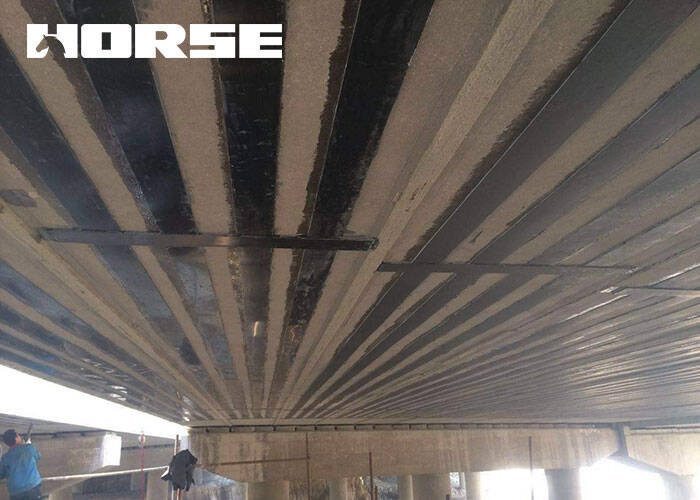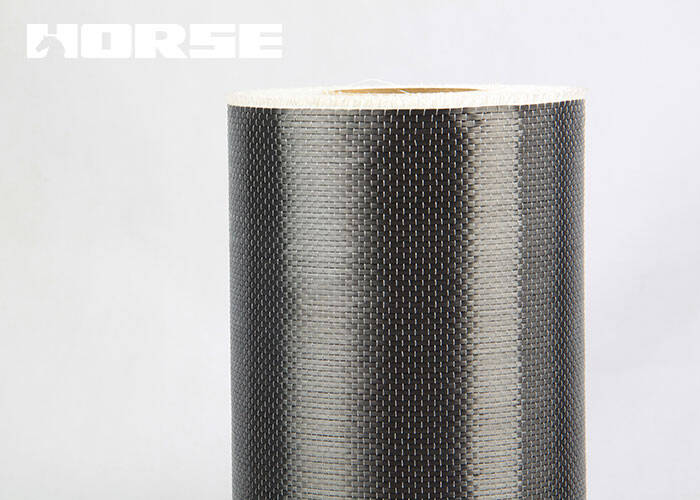Solutions
Horse Construction offers full range of structural strengthening materials with technical supports, documentation supports, products supports, project supports.
Application of carbon fiber CFRP materials in bridge strengthening

The bridge will inevitably have diseases after long-term use. These diseases not only affect the normal use of the bridge, but also cause a series of safety hazards. Therefore, we should pay attention to and strengthen the treatment of bridge diseases, and do a good job in bridge repair and reinforcement. Among the many maintenance and reinforcement technical measures, the pasting of carbon fiber sheet is more commonly used, which is not only effective, but also low in cost, and does not have the disadvantages of increasing structural sections.
1 Material requirements
During the reinforcement construction, the adhesive and carbon fiber materials should be provided by specialized manufacturers. The mechanical properties of carbon fiber materials should meet the following requirements: tensile strength should reach 3400MPa or more; elastic modulus should reach 2.4×105MPa or more; elongation at break should reach 1.7% or more. In addition, the tensile strength of carbon fiber materials must not be less than 95% retention rate, and all performance indicators are calculated based on the net area.
In terms of weather resistance, the following requirements should be met: there should be no cracks, spots or blisters in appearance, and the size should be stable; the tensile strength should have a retention rate of not less than 95%, and the elongation rate should also have a retention rate of more than 95% .
The performance index of the adhesive should meet the following requirements: density is in the range of 1100~1700kg/m3; elastic modulus is 0.5~20GPa; shear modulus is 0.2~8GPa; Poisson’s ratio is 0.3~0.4; tensile strength is 9~ 30MPa; shear and compressive strengths are 10~30MPa, 55~110MPa respectively; tensile strain at break is 0.5%~5%; coefficient of thermal expansion is 25~100/(10-6/℃); glass transition temperature is 45~80 ℃.
In order to achieve the ideal bonding quality, the dipping glue used in the bonding process needs to be tested for strength before formal use. The compressive strength must be above 70MPa, and the bonding strength must be above 2.5MPa.

2 Construction preparation
(1) Read the design and construction drawings carefully before the start of construction, and locate the line to be reinforced according to the content of the design drawings.
(2) Based on the actual situation of the site, combined with the status of the components to be reinforced, a reasonable and feasible construction plan is prepared, a construction plan is made, and strictly implemented during the construction process.
(3) Conduct a comprehensive inspection of all materials, machinery and equipment that need to be used in the construction to make it in the best condition and avoid construction interruption due to this aspect.
3 Construction technology and quality control
Construction process of bridge pasting carbon fiber materials reinforcement
3.1 Surface treatment
Before sticking the carbon fiber materials, the surface of the component should be treated as necessary:
(1) Clean up the corrosion, spalling and looseness on the surface of the components until the fresh concrete surface inside is exposed. If the area of the deteriorated layer is relatively large, it should be repaired with cement mortar after removing it.
(2) Check the directly exposed steel bars to confirm whether they are corroded. When corrosion is found, rust removal should be carried out immediately.
(3) For cracks, they should be effectively treated by sealing or grouting.
(4) The surface of the area to be reinforced needs to be polished to be flat before construction, especially the protruding surface must be polished, and the oil and scum must be removed until the fresh surface inside is exposed. When pasting at the corners, chamfering should be done, and at the same time, it should be polished into an arc shape with a radius of more than 20m. Finally, use special repair materials to repair the surface to make it flat.
(5) After finishing the surface grinding treatment, use a vacuum cleaner to clean up the dust attached to the surface while keeping it in a dry state.
3.2 Preparation and brushing of the primer
(1) The bottom layer glue must be prepared according to the requirements of the manufacturer, and the method allowed by the specification is adopted.
(2) Based on the standard dosage, combined with the area of the coating, the actual dosage of the bottom layer glue is accurately calculated. And according to the weather and other conditions, to ensure that it can be used in one time within the use period, and mix and stir it to uniformity according to the required ratio.
(3) Use a roller brush or a fur brush to evenly apply the bottom layer glue on the surface of the component to be reinforced, and its thickness should be controlled within 0.4mm. Pay attention to the absence of bubbles and flow. After the bottom layer glue has solidified, the specific solidification time should be determined according to the temperature and other conditions. It can be done after the finger touches and feels dry. It usually takes more than 2 hours. After confirming the solidification, the next process can be entered.
3.3 Sticking surface leveling
(1) Prepare leveling materials according to the relevant requirements put forward by the supplier. Generally, epoxy putty is used.
(2) Before the surface repair, use acetone solution to scrub the surface, use a spatula to fill the recessed part, and then repair it and level it. The level of leveling is controlled based on the visual inspection without obvious traces and lines. The corners and the parts with differences in level need to be painted into a smooth surface.
(3) The processing of the corner needs to use special leveling materials to repair it into a smooth arc surface, and the radius should be more than 10mm.
(4) After the leveling material is completely solidified, the specific solidification time should be determined according to the temperature and other conditions. When the fingers feel dry, it usually takes more than 2 hours. After confirming the solidification, the next process can be entered.
3.4 Cutting of carbon fiber materials
(1) Cut the carbon fiber materials that has passed the field inspection according to the size required by the design. In the actual cutting process, oblique cutting is not allowed, and wire drawing should be avoided. Special personnel are arranged on site for inspection, supervision and control.
(2) After finishing cutting, the carbon fiber direction of the carbon fiber materials must be consistent with the position to be pasted, so that the pasting can be completed smoothly and the ideal pasting effect can be achieved.
(3) After the carbon fiber materials is cut, it should be protected from contamination.
3.5 Prepare and evenly apply adhesive
(1) Before preparing the adhesive, read the instructions carefully to master the main points and all precautions of the preparation.
(2) The quantity of adhesive is determined by calculation strictly according to the sticking area to avoid unnecessary loss and waste.
(3) The preparation should be carried out in strict accordance with the weight ratio required by the design, and the process method proposed by the manufacturer should be adopted, and a special person should be arranged for inspection. The mixing of the glue should be carried out continuously in a clockwise direction until the color is uniform and no bubbles are generated. At the same time, effective measures should be taken to prevent debris from entering the glue.
(4) After the adhesive is prepared, it should be used as soon as possible. Use a brush or rolling brush to apply it evenly and without omission to the surface of the concrete member to be reinforced. The area of the applied surface cannot be smaller than the area of the carbon fiber materials.
3.6 Pasting carbon fiber materials
(1) Wipe the components before pasting to prevent dust from affecting the pasting effect.
(2) Spread a layer of structural glue evenly on the surface of the concrete. The application should be stable, accurate and even, that is, the glue should be applied moderately, that is, it should not flow or fall; the brush should not exceed the control line; In the brush range, the thickness should be consistent.
(3) In the process of pasting carbon fiber materials, the above requirements must be met.
(4) When rolling carbon fiber materials, it should be implemented continuously from one end to the other end. Do not roll and knead the same area multiple times. Rolling makes the glue liquid penetrate into the carbon fiber materials, remove the excess glue liquid and bubbles, make the infiltration full, and completely bond with the bottom layer. If the carbon fiber materials is to be overlapped, the width of the overlap should be more than 100mm.
(5) In the process of multi-layer bonding, it is necessary to apply the next layer after the previous layer is dry to the touch of the fingers. If the time exceeds 40 minutes, it needs to stand for 12 hours before applying the next layer.
3.7 Surface protection
After the above construction is completed, natural maintenance is started. It is required that it will not be impacted by external force or wetted by rain within 24 hours. If surface protection is required, it must be properly treated in accordance with relevant requirements to ensure that the carbon fiber materials and protective materials are well bonded and remain reliable. . If there are vent holes on the surface of the bottom plate, the carbon fiber materials cannot be blocked after being pasted.
3.8 Quality inspection and acceptance
The quality acceptance after the completion of the construction is mainly based on the comprehensive assessment of the bonding quality. Use a simple tool such as a hammer to tap the surface of the carbon fiber materials, and then judge the bonding effect through echo. If hollowing occurs, it needs to be remedied by needle grouting. If the bonding area is within 90%, the bonding quality does not meet the requirements, and the construction should be repeated.
4 Conclusion
In summary, pasting carbon fiber materials is a commonly used maintenance and reinforcement measure for bridge engineering, which has the advantages of convenient construction and significant effects. The construction should be carried out in strict accordance with the relevant process requirements, and quality inspections and inspections should be done to ensure the quality of the carbon fiber materials paste to achieve the ideal maintenance and reinforcement effect.
You can find anything here you are in need of, have a trust trying on these products, you will find the big difference after that.

High strength carbon fiber reinforced polymer (CFRP) strip / laminate / plate for structural strengthening and concrete repair

Prestressed carbon fiber reinforced polymer(CFRP) plate for slab, beam strengthening to increase stiffness, reduce distortion and deflection of members, reduce the cracks, avoid and stop cracking.

High strength, unidirectional carbon fiber sheet pre-saturated to form a carbon fiber reinforced polymer (CFRP) sheet used to strengthen structural concrete elements.